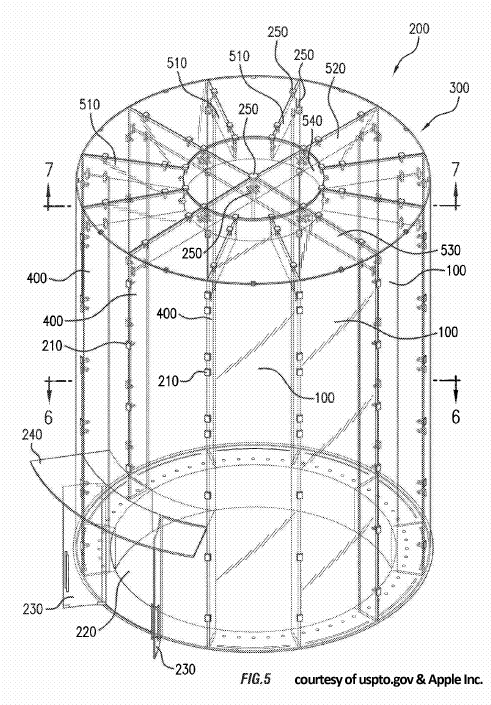On Thursday, Apple Inc. (NASDAQ:AAPL) filed an unusual patent application with the United States Patent and Trademark Office (USPTO) simply entitled “Building.” This document describes a process for making a cylindrical, tower-like building entirely out of glass, except for a few metal fasteners. Several different kinds of “monolithic” glass pieces are combined, including a number of variants of supports, beams, panels, and fins, to make a tubular structure capable of providing robust structural support to itself though composed of glass.
The patent application, #20140096456, shows a building made up of curved pieces of glass. According to the information supplied in the document, each piece can be made up of three to five layers laminated together and secured with tough adhesives. It is a well known principle of engineering that lamination increases the strength of an object if it is arranged correctly. With each layer up to 9/16 inch thick, a glass “beam” of five layers would total roughly 2.8 inches.
The designers note that the great strength and toughness of laminated glass overcomes previous size limitations on a building made out of this transparent substance. All previous designs used non-laminated glass, preventing large buildings from being constructed in this way. Though still naturally more limited than steel, the Apple Inc. (AAPL) version of laminated glass building would increase the potential size of a structure hugely.

Some of the panels included in the design are colossal, with one side measuring up to 45 feet. Transparent adhesive would be used to bond layers together in order to preserve the overall glassy transparency of the whole structure. Several adhesives are recommended by the inventors, including a specific brand by DuPont and generic polyvinyl butyral. Depending on the structural needs of a specific piece, the layers could be uniform in thickness or be very different.
The patent application is notable not only for its idiosyncratic subject, but also for the number and global distribution of the inventors contributing to it. The application bears the names of nine inventors, including five from America (David Andreini, Karl Backus, John Cooksey, Tim Eliassen, and Scott David Hazard); two from Great Britain (Peter Lenk and James O’Callaghan); one from Germany (Holger Krueger); and one from China (Yutang Zhang). The application was filed on September 30th, 2013, though not published until April 10th, 2014.
A similar patent was already granted and used for a cylindrical entrance to Apple’s (AAPL) Shanghai store. This patent is described as a “continuation” of the original patent. Though very similar, the two patents are a sign that Apple views this type of construction as highly significant in some way. Spending $8,000 to $10,000 or more per patent does not make sense if the Cupertino firm only intends to use the idea to build what amounts to a single glass awning for one retail store.



